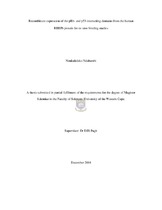Recombinant expression of the pRb- and p53-interacting domains from the human RBBP6 protein for in vitro binding studies
Abstract
This thesis describes the cloning and recombinant expression of domains from the human RBBP6 protein for future in vitro binding studies with pRb and p53. RBBP6 is a splicing-associated protein that is known to interact with both p53 and the Retinoblastoma gene product (pRb), and has recently been shown to be highly upregulated in oesophageal cancer. The pRb binding domain (RbBD) and the p53 binding domain (p53BD) were each expressed using the glutathione-S-transferase (GST) tag affinity system, and affinity purified using a glutathione-linked agarose column. Purified fusion proteins were cleaved to separate the target protein from GST using PreScission™ Protease, for which there is a recognition sequence located immediately upstream of the multiple cloning site on the pGEX-6P series of plasmids. The pRb binding and p53 binding domains were further purified using cation exchange chromatography. Mass spectrometry confirmed that the RbBD was expressed as a single species of the expected molecular weight. However preliminary NMR analysis suggested that the domain was not fully folded. A total yield of 8 mg of protein was achieved from 1l of culture, which make it feasible to express 15N and 12C labelled samples for NMR. The p53BD was found to be expressed at lower levels and subject to C-terminal degradation, which suggest that the C-terminus is unstructured most likely due to the presence of poly-lysine tail. Human pRb protein was also successfully expressed and purified using the GST affinity system. Human p53 protein was expressed but was found to be insoluble and attempts to purify it were not pursued. Attempts to confirm the interactions between human RBBP6 and p53 and pRb proteins are on-going but fall outside the scope of this thesis. Expression constructs for the RING and zinc finger domains from human RBBP6 were also cloned into the pGEX system for future structural studies using NMR. Both domains were found to be expressed as soluble fusion proteins in preliminary expression studies.

